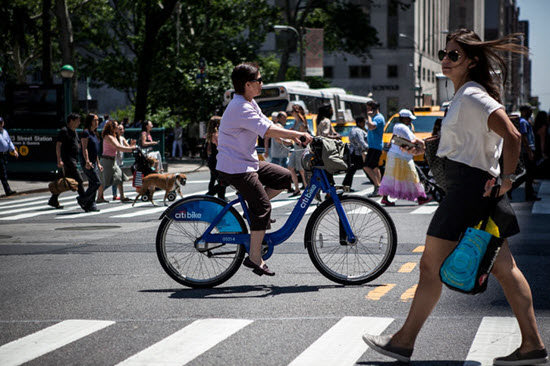
Image from www.nytimes.com/
Understanding WHY something "is" the way it "is" is fascinating to me. Outdoor road riders tend to be predominantly men... and Indoor Cycling participants are far and away women. So why is that?
OK, I already know why - outdoor cycling has an element of risk that's more acceptable to men, than women. My wife Amy is much more comfortable at speed on the back of our tandem, than she would be piloting her own bike. And it's not just me who's figured this out. Citi Bike has too.
A Mission for Citi Bike: Recruiting More Female Cyclists
When Citi Bike arrived here, it promised to spread the benefits of biking to the masses, an uphill push in a city where large potholes, heedless yellow cabs and darting pedestrians can make riding on busy streets seem like an activity best left for daring messengers.
But two years in, Citi Bike”™s inroads have been decidedly uneven, with men far outnumbering women in using the bike-sharing system. A little time on Eighth Avenue on a recent morning, watching the stream of Citi Bike riders heading north past Pennsylvania Station and toward Times Square, was instructive. Man after man pedaled by, some in suits, others in jeans. From time to time, a woman on a Citi Bike rode by.
Reasonable (and observant) people already understood this, so I'm not sure why this is even a question. Men are by nature more reckless and more tolerant/accepting of risk than women.
“Women are early indicators of a successful bike system,” said Sarah M. Kaufman, the assistant director for technology programming at the Rudin Center for Transportation at New York University and an author of a new report on Citi Bike. “If you have more women riders, that means it”™s convenient and safe.”
Officials at Citi Bike say they are attracting a greater share of women than the citywide rate of female cyclists – about 21 percent, according to a study from Hunter College. The bike-sharing service is looking at more than just the safety concerns that seem to nag more at women than men, who insurance actuaries long ago concluded are more likely to engage in risky behavior, such as not wearing a bike helmet.
Anyone who's insured young drivers (like me), are thankful they had daughters - not sons - when they get their insurance bill. Young women are less likely to do stupid/risky stuff in a car = they crash less often = they're less of an insurance risk.
This isn't rocket science here people. And yet I'm continuously seeing instructors and studios focusing their marketing at men... who ride outside... and will probably never set foot in your class. While successful (read profitable) fitness businesses like SoulCycle cater almost exclusively to women.
My advice to Citi Bike is to accept the reality here (women don't feel safe riding in traffic) and quit coming up with stupid non issues like not having a place for their kids.
And there are other perceived obstacles, not unique to women but more commonly cited by them: They cannot ride with small children. They think the cost – $149 for an annual membership or $9.95 for a day pass – is too steep, especially on top of a subway pass. And they worry about arriving at work sweaty.
“I wouldn”™t want to be gross the whole day,” said Maeve McCarthy, 21, an intern at an interior design firm in Manhattan, who has not tried Citi Bike but said she would consider taking a nice ride through Central Park, if not commuting to work from Brooklyn.
Ms. McCarthy just doesn't want to smell sweaty the rest of the day... and I don't want to sit next to her if she does 🙁
There's an old saying; "you can't fight city hall". It points to the futility of trying to change something that just ain't going to change... no matter how hard you wish it to change.

